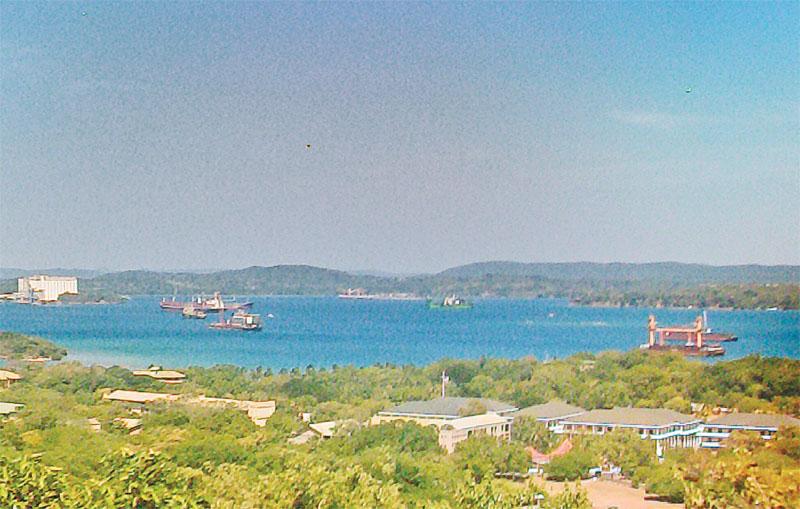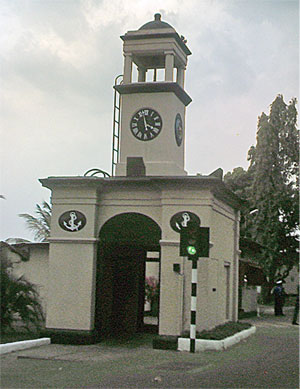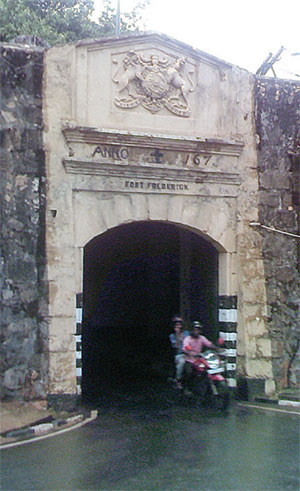
Surrounded by serene beaches and the ocean, the town of Trincomalee is a unique travel destination. Its resplendent aura is further enhanced by maritime history, which stands today having somehow withstood senescence. The natural harbour with its deep water capacity attracted the British East Indies fleet to set up a naval presence as early as 1795. Older European colonial powers had previously entrenched themselves in Trinco, so attractively located geo-strategically.
Massive coastal guns were a feature colonial British maritime defence. If you have watched the old movie ‘Guns of Navarone’, you would remember such a gun battery. All that remains of the Ostenburg Ridge battery is a solitary, huge, 12-ton cannon. It is a classic remnant of old Ceylon. Three such guns originally made up the battery. The innovative British had used elephants to haul the guns into position high on the Ridge.
Over the years, the British naval station established many fortifications and the town blossomed into a garrison city. I simply could not comprehend the vast area of 850 acres that come under the jurisdiction of the Eastern Naval Command. While being shown around by my Navy guide, I reminded myself that the Navy area was only a part of the many small and large bays, coves, and inlets, including the commercial port, that open on to the vast Koddiar Bay.
 Coastal defence cannon |
The oldest traffic signal light system installed in Ceylon still operates on the Trinco Navy Base. Let me describe the small selection of sights in the Navy area.
Navy House
One of the buildings that majestically rise from a cliff is the Navy House. Permission was granted to me by the Admiralty to visit this wonderful abode. The immaculate lawns and flower beds are an expression of naval discipline. The front view of this stately mansion resembles two decks of a merchant ship. The residence was originally built by a Moor in the 18th century. In 1812, Vice Admiral Samuel Hood, one of the British Royal Navy’s most famous commanders, became its first resident. The open verandah is referred to as the Stern Walk. A large bell positioned near the entrance caught my eye. Apparently, this bell had been brought from Myanmar. The wooden staircase of the house leads up to a grand upper floor with rooms to accommodate special guests. Today, the mansion is reserved for use by the President, visiting Heads of State and the Commander of the Navy.
There is a remarkable naval tradition here: all resident guests can sign their name on plaster of Paris, which is then framed and mounted on a wall. The balcony offers a panoramic view of the Trinco harbour with its many small islands. A sturdy dining table is laid out with antique cutlery. A brass plaque captures the essence of naval duty as stated by Lord Nelson “Duty is the greatest business of a sea officer, all private consideration must give way to it, however painful it may be.”
Ostenburg Ridge
Covering an expanse of almost 7.5 acres is Ostenburg Ridge, a high point that overlooks the naval harbour. The broad ridge offers a vantage point for defence, and the British Admiralty positioned some of its coastal defences here. Primary among them is Hoods Tower built by Vice Admiral Hood. The tower is three stories tall. As I climbed to the top the view of the harbour was exhilarating. The top of the Tower was used by sentries to monitor the approaches to the harbour. If hostile craft were detected the Officer of the Watch would dial the alarm to the gun battery at ‘Gun Site’. The Navy has taken care to preserve the old service telephone used for this purpose.
Coastal cannon
Massive coastal guns were a feature colonial British maritime defence. If you have watched the old movie ‘Guns of Navarone’, you would remember such a gun battery. All that remains of the Ostenburg Ridge battery is a solitary, huge, 12-ton cannon. It is a classic remnant of old Ceylon. Three such guns originally made up the battery. The innovative British had used elephants to haul the guns into position high on the Ridge.
 Oldest traffic lights signal in Sri Lanka which is still in operation |
Beneath the big gun is an underground concrete bunker for the ammunition supply. I made the steep descent going down 25 feet. The steps had been inlaid with silica particles to illuminate the path under moonlight for night time operations. The deep armoury has a built-in conveyer belt that sent the 45 Kg shells upward for loading during battle. The bunker has provision for cooking and a rest area for the 17- man artillery crew.
Japanese air raid in 1942
The Imperial Japanese Fleet under the command of Admiral Nugumo was on a mission to attack and sink allied ships. The Japanese fleet sent out reconnaissance aircraft from the Japanese vessel ‘Haruna’. The British Navy’s lead ship, the aircraft carrier HMS Hermes, under the command of Captain Richard Onslow, was anchored several nautical miles away from Trincomalee. Her air defence planes were not on board. The delighted Japanese air patrol spotted their target and radioed in for an air strike, and 70 Japanese bombers ferociously attacked the Hermes. She courageously kept sailing under fire. After successive strikes by the Japanese air force, the gallant ship was engulfed in flames and sank, taking down 307 brave sailors. The Australian destroyer HMAS Vampire was also sunk in this raid. The seas around Trincomalee are the final resting place for ships sunk during the Second World War.
I also visited the British War Cemetery with its immaculate turf, where many sailors rest in peace from the period 1939 to 1945.
Today, one can undertake a dive to some of these sunken ship locations, as there are a few scuba diving schools open for tourists.
Fortifications of Parakramabahu the Great
There is a naval museum situated on an elevated rock formation where famous King Parakramabahu (1123-1186) had rallied his army and seaborne forces at Gokkana (ancient name for Trincomalee port). This warrior monarch had built up his own naval forces to establish his writ in the ocean around Sri Lanka. The ruins of some of his coastal fortifications still remain. From here, he built foreign trade with China and West Asia.
During his rule the King of Myanmar (state of Bagan) had humiliated the envoy of Parakramabahu by imprisoning him. The infuriated monarch ordered his ships to set sail with a large army. Elephants were taken as mounted cavalry. The invading force landed in the town of Kusumiya and subdued the ruler of Myanmar.
Today, the Navy museum showcases old machines, guns, sea mines and artifacts, mainly from the colonial era, in good condition.
Fort Frederick, Orr’s Hill Army Museum and Koneswaram Kovil
The Hindu devotees gather in hundreds to venerate the ancient temple-shrine of Koneswaram, which some opine had been in existence from the 3rd century. The temple was destroyed by the invading Portuguese in 1622 and later rebuilt with grandeur. After the Portuguese committed this sacrilege they built a magnificent fort, later known as Fort Frederick in 1623. The invading Dutch then captured the fort in 1639.
 Entrance to Fort Frederick |
Subsequently, in 1672 the French attacked and captured the garrison. Today, part of this site is home to an Army detachment, which adds to its historical military heritage. I looked down into the deep crevice of the Ravana Cliff, seeing the famously scary drop all the way down. The ringing of the kovil bell resonates with the sea breeze. It was rather disappointing to note that the path leading to the temple has become a small bazaar of noisy vendors, who disturb the spiritual essence of the site.
A few kilometers away are the famed hot springs of Kinniya, also a site of Hindu worship. Again, this location has become a commercial hub, often overcrowded.
The 22 Division of the Army has recently opened an impressive war museum at Orr’s Hill, displaying many interesting exhibits in a immaculately landscaped area, bordering the sea. The open air museum showcases some heavy armoured vehicles and also has a resource centre.
The Navy operates a resort on Sober Island (first occupied by French Admiral Jacob de la Hay in 1672) with cozy accommodation, reasonable cuisine and an inspiring boat ride. Boats can also be hired for whale watching. The resort is a perfect haven for rest.
Trincomalee is the best destination for one seeking an insight into maritime and military history and also to enjoy the unspoilt pristine beaches and turquoise waters of the ocean.
